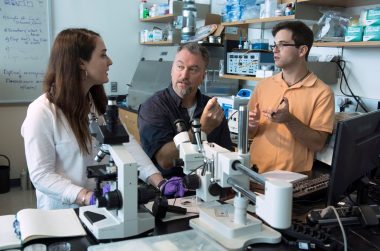A team of Elon researchers is working to develop an efficient and effective way for communities in the developing world to help combat water, sanitation hygiene problems.
For the 2.5 billion people worldwide without access to safe and affordable sanitation, a competitive challenge to reinvent the modern toilet isn’t just a high-tech competition, but a potential lifesaver.
An initiative of the Bill & Melinda Gates Foundation, the Reinventing the Toilet Challenge is backing teams of researchers around the world to develop an efficient and effective way for communities in the developing world to help combat water, sanitation and hygiene problems. Now a team of Elon faculty and student researchers is playing a key role in one team’s effort to develop a toilet that can operate “off the grid” in a cost-effective and sustainable way while removing germs from human waste and recovering energy, clean water and nutrients.

The challenge for Elon’s research team is how to kill the eggs of helminths, which are parasitic worms that can impact a host’s ability to absorb nutrients and in turn cause weakness and disease. The eggs are commonly found in human waste in the developing world, but a multilayered casing of the eggs is nearly impermeable by common disinfectants such a bleach and other chemicals. “Most developing countries have a major disease burden from helminth,” says Charles Parker, director of the nanomaterials and thin films lab at Duke’s Pratt School of Engineering, and a visiting professor at Elon who is working on the project. “It’s particularly a problem where wastewater is used to irrigate crops. It’s such a bad problem that the World Health Organization isn’t even trying to eliminate it — they are just trying to reduce the amount of it.”
That’s where electroporation comes in. The Elon team is focused on employing this technique, which uses electrical pulses to open pores in substances, to create tiny holes in the helminth eggs so more traditional disinfectants can penetrate the eggs and destroy them. The approach was inspired by earlier research by Chris Arena, a former assistant professor of engineering at Elon who is now at Virginia Tech and used electroporation to destroy tumors. Though Arena is no long at Elon, he continues to work on the project with the Elon team. “By using a changing electrical field, we can open up small holes in the walls that protect the helminth eggs, and then use the same disinfection species we’re using to eradicate everything else,” Parker says. “Potentially, if this is a good approach, it could be rolled out to other teams who are working on the toilet challenge.”
Dryzer and Niven have made key contributions to the effort. Niven is majoring in biochemistry and interned with RTI this past summer to work on the project. She helped determine that C. elegans, a nonparasitic roundworm species that is far less hazardous than hellminths, was the ideal substitute for use in the lab as the team experiments with using electroporation to attack the eggs. Dryzer, who is pursuing this research as a Lumen Prize winner, pursued the idea of using specific chemicals to peel back external layers of the eggs so that the electroporation can more efficiently attack the harder-to-penetrate interior layer. Now they’ve determined that electroporation can open up holes in the eggs, the focus now is on how to produce the effect using the least amount of energy, says Dryzer. “We need to find out the minimum it takes to form pores in the eggs to kill them, since we’re trying to put this to use in a toilet that is supposed to be self-sufficient,” he said.
That’s part of the broader, overall challenge—not just develop the technologies and techniques needed to reinvent the toilet, but to produce a prototype that is cost-effective and sustainable. That’s making this a true team effort, with different researchers tackling their own portions of the challenge, while also looking at the bigger picture of how these different developments will come together to produce a new toilet that can have long-term public health benefits. A prototype built by RTI and testing out various aspects of the design is now in place in India, and the hope is that the Elon team’s findings will be integrated into future prototypes to address the helminth problem. The team is working toward publishing its findings regarding the impact of electroporation on C. elegans eggs later this year. “This is so great, for Caitlin and Michael to be exposed to this intense research environment, and the collaborations that are taking place across teams,” Wolter says. “This is creating new research experiences for students, and also opening up more and more research opportunities for Elon to participate in.”
Neiven agrees. “My experience with this effort has really illustrated the true nature of research—that you kind of have to create your own path,” she says. “It’s just such a powerful experience realizing that we are part of an effort to truly make a change in the world that can extend across all boundaries, and benefit everyone.”
—
This article appeared in the Fall 2017 Magazine of Elon.


